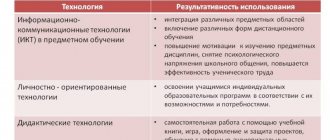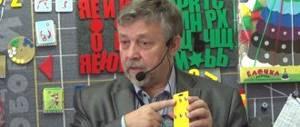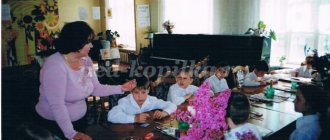The use of electronic presentations in the educational process of preschool educational institutions
Bibliographic description:
Sizyakova, N. N. The use of electronic presentations in the educational process of preschool educational institutions / N. N. Sizyakova. — Text: immediate // Current tasks of pedagogy: materials of the VIII International. scientific conf. (Moscow, November 2020). - Moscow: Buki-Vedi, 2020. - pp. 64-66. — URL: https://moluch.ru/conf/ped/archive/272/13178/ (date of access: 10.10.2020).
In our fast-moving times, computerization has penetrated almost all spheres of life and activity of modern people. Therefore, the introduction of computer technologies in preschool education is a necessary step in the development of the modern information world as a whole. Communication with a PC arouses keen interest in children, first as a gaming activity, and then as an educational activity. The novelty of computers and interactive equipment is reflected in the development of the child’s cognitive interests and in changes in the dynamics of mental development. In the process of educational activities using a computer, children's memory and attention improve, since the computer transmits information in a form that is attractive to the child, which not only speeds up the memorization of the content, but also makes it meaningful and long-lasting. Properly selected tasks and video materials help increase children’s motivation to study. The use of information technologies in the process of educational activities in preschool educational institutions makes it possible to overcome the intellectual passivity of children and makes it possible to increase the effectiveness of the educational activities of preschool educational institutions teachers.
One of the current areas for introducing information technologies into the educational activities of preschool educational institutions is multimedia presentation technologies. Electronic presentations are a convenient and effective way to present information using computer programs. It combines dynamics, sound and image, i.e. those factors that hold the child’s attention for the longest time. This is clarity, allowing the teacher to build an explanation in the process of educational activities logically, scientifically, using video material. With this organization of material, three types of children’s memory are included: visual, auditory, motor. The presentation makes it possible to consider complex material step by step, to address not only the current material, but also to repeat the previous topic. You can also go into more detail on issues that cause difficulties. The use of animation effects helps to increase children's interest in the material being studied.
The use of presentation tools allows you to bring a visual effect to the lesson, helps the child learn the material faster, and focuses attention on the significant points of the information presented; create visual, effective images in the form of diagrams, diagrams, drawings. Graphic compositions. Therefore, presentations are becoming an increasingly popular and effective form of conducting classes. They are quite easily created using the Power Point program, which is included in the Microsoft Office suite along with the familiar Microsoft Word text document creation program, only instead of text pages, Power Point consists of slides that can be shown on a computer screen, on a shared screen, or on interactive whiteboard. For a teacher, this program opens up a wide range of opportunities, as it is easy to use, requires almost no special skills, and allows you to create not only illustrative illustrations, but also interactive games, tests, and even cartoons. In this program you can make reports, virtual excursions, use it in the process of additional education, to defend projects. In the conditions of modern society, the information competence of a teacher, his ability to solve professional pedagogical problems using information and communication technologies, becomes an important component of his professionalism.
The rapid development of electronic presentations and the scale of their application in the field of education are explained by the numerous advantages of use. These include information capacity, compactness, accessibility, visibility and emotional appeal, interactivity, mobility, and multifunctionality. Compared to traditional forms of teaching preschoolers, the computer has a number of advantages:
– presenting information on a computer screen in a playful way arouses children’s interest;
– carries a figurative type of information that is understandable to preschoolers;
– movements, sound, animation attract the child’s attention for a long time;
– problematic tasks, encouraging the child to solve them correctly with the computer itself are a stimulus for children’s cognitive activity;
– provides the opportunity to individualize training;
– the child himself regulates the pace and number of game learning tasks to be solved;
– in the process of working at the computer, the preschooler gains confidence that he can do a lot;
– allows you to simulate life situations that cannot be seen in everyday life (volcanic eruption, avalanche, etc.);
– the computer is very patient, never scolds for mistakes, but waits for the child to correct them himself.
In my work with children of senior preschool age, I use presentations at various stages of working with children: as a means of clarity in educational activities when learning new material, to consolidate what has been learned, to control and test knowledge (quizzes, tests), and to assess individual development (tests). As practice has shown, thanks to the use of electronic presentations, children are active in the classroom. Their interest in the material they are studying has increased; due to the high dynamics, they learn the material more effectively, train their attention and memory, actively expand their vocabulary, and develop sense of purpose and concentration. Imagination and creative abilities develop.
Designing classes using multimedia technologies is a new direction in the activities of preschool teachers, and this is where all the accumulated experience and creative approach can be applied. Educational activities carried out in kindergarten using electronic educational publications will be remembered by children for a long time. At the same time, of course, the most important role in education remains the role of the teacher, who cannot be replaced by any computer.
Literature:
- Leonenko O. B. The use of multimedia presentations in preschool educational institutions//Handbook of senior educators. 2009. No. 4. P. 32.
- Polat E. S. New pedagogical and information technologies in the education system. - M.: Publishing House, 2000.
- Sapozhnikova N.V. Information technologies in methodological work // Kindergarten from A to Z. - 2007. - No. 4. - P. 111.
Key terms
(automatically generated)
: educational activity, child, child's attention, computer, presentation, computer screen.





